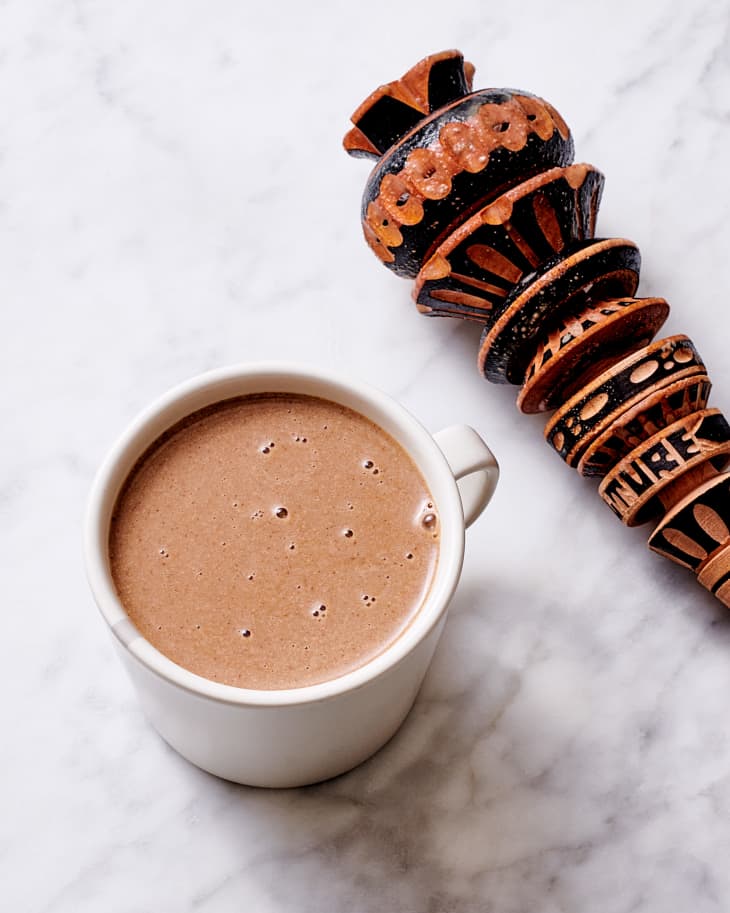Champurrado

A rich chocolate beverage seasoned with cinnamon and spices, sweetened with unrefined whole cane sugar, and thickened with masa harina.
Serves6 to 8
Makesabout 7 3/4 cups
Prep5 minutes
Cook15 minutes to 20 minutes
When I was growing up in Sonora, Mexico, as soon as temperatures started dropping my mamá would make champurrado. It was such a treat, whether for breakfast or in the late afternoon as a snack with some freshly cooked churros. We made ours with chocolate from Chiapas, which had a red clay look and was 70% (or higher) dark chocolate. It was delicious!
In Mexico, we kick off the holiday season with Day of the Dead as we honor those friends and family that have passed. Children often write calaveras, which is a form of poetry about celebration of death. All over the country they submit their entries to the newspaper in hopes to get published. I have fond memories of trying to write my own poetry while my mamá served me champurrado. The next holiday is the Guadalupe Virgen day on December 12. Across the country churro stands pop up in decorated street corners and everyone is serving champurrado. If you are not part of a float that is doing the Guadalupe Virgen procession, you are watching it from the sidewalk while, you guessed it, drinking champurrado. I can’t imagine a holiday season without it.
What Is Champurrado?
Champurrado is a type of atole with chocolate that gets its name from the verb “champurrar” which means to mix. Traditionally the liquid is mixed with a molinillo, a wooden whisk where you roll the shaft between your palms until you achieve desired frothiness.
Atole is a beverage which usually consists of masa harina or fresh milled masa, spices, piloncillo (find more information below), and water. There are countless variations — many add milk, some add orange peels, and others add different spice mixes. And, of course, the landrace of corn you use will influence the flavor profile. In the Northern states, you will see atoles made with white, blue, and red corn varieties. In the South, atoles are mostly made with white and yellow corn.
The difference between an atole and champurrado is the addition of chocolate and frothing the liquid.
What Is Masa and Masa Harina?
Masa is the output of grinding corn that has been nixtamalized. Then masa is typically used to make tortillas, tamales, and many other creations. When fresh masa is dehydrated and pulverized you get masa harina (not to be confused with corn flour). Corn flour is dried corn kernels that have been ground until the mixture becomes flour. Masa harina is available at most grocery stores.
Selecting Chocolate and Spice Mixes
- Chocolate: Chocolate grown in Mexico and used in Mesoamerican cuisine was typically not sweetened. Today you can find most of Mexico’s fine chocolate in Tabasco and Chiapas. When possible, choose dark varieties, then adjust the sweetness to your taste.
- Spices: Cinnamon is a must. But you can choose to add other spices and aromatics such as star anise, vanilla beans, cloves, peppercorns, and orange peels, too.
What Is Piloncillo?
Piloncillo is unrefined whole cane sugar. It is also known as panela, raspadura, and panocha in other countries. You can find two varieties: dark and light. Color is indicative of the variety of sugarcane plant; dark comes from purple varieties and light comes from green ones.
Dark piloncillo tends to be more of a burnt caramel intensity and very aromatic; light piloncillo is mild. Piloncillo is not the same as brown sugar, which is white sugar combined with molasses for color and taste. While piloncillo is essential in making champurrado, you can sub with dark brown sugar if you can’t find it.
Champurrado Recipe
A rich chocolate beverage seasoned with cinnamon and spices, sweetened with unrefined whole cane sugar, and thickened with masa harina.
Prep time 5 minutes
Cook time 15 minutes to 20 minutes
Makes about 7 3/4 cups
Serves 6 to 8
Nutritional Info
Ingredients
- 2
(about 3-inch) cinnamon sticks
- 5
whole black peppercorns
- 2
whole cloves
- 4 cups
water
- 1
(8-ounce) piloncillo (unrefined cane sugar) cone, such as Goya
- 3 cups
whole milk or unsweetened oat milk
- 2.7 to 3.17 ounces
dark chocolate (70 to 85%) or Mexican chocolate, such as Taza Super Dark 85% (one 2.7-ounce package) or Ibarra or Abuelita tablets (one 3.17-ounce tablet)
- 1/2 cup
masa harina
- 1/8 teaspoon
kosher salt
Instructions
Place 2 (about 3-inch) cinnamon sticks, 5 whole black peppercorns, and 2 whole cloves in a small saucepan. Toast over medium heat, shaking the pan occasionally, until fragrant, 3 to 4 minutes.
Add 4 cups water and 1 piloncillo cone. Increase the heat to medium high and bring to a simmer, carefully breaking the piloncillo apart with a spoon and stirring until it's fully dissolved. Let simmer for 5 minutes. Meanwhile, place 3 cups whole or oat milk and 2.7 to 3.17 ounces dark chocolate or Mexican chocolate in a large saucepan. Place on medium-low heat and whisk to dissolve the chocolate.
Pour the spice syrup through a fine-mesh strainer into the chocolate mixture; discard the contents of the strainer. Bring to a simmer, whisking to make sure the chocolate is dissolved. While whisking vigorously, slowly pour in 1/2 cup masa harina (the mixture will thicken). Continue to simmer, reducing the heat as needed and whisking or rolling a molinillo between your palms constantly to froth the champurrado, for 2 minutes. Add 1/8 teaspoon kosher salt and cook for 1 minute more.
Recipe Notes
Piloncillo substitute: 8 ounces dark brown sugar can be substituted for the piloncillo.
Storage: Leftovers can be refrigerated in an airtight container for up to 5 days. Stir to recombine and reheat in the microwave or over low heat on the stovetop.
